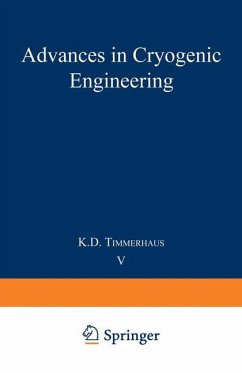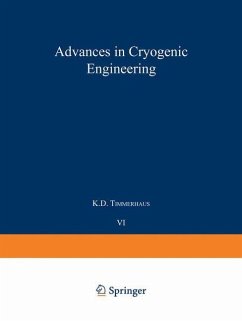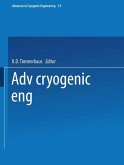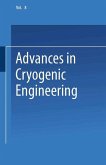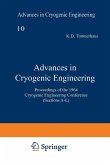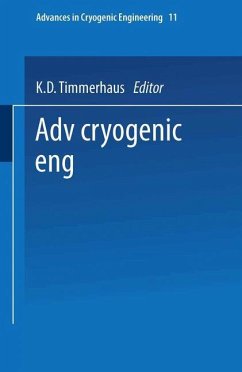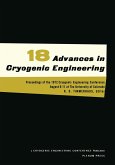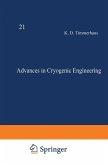Klaus D. Timmerhaus
Advances in Cryogenic Engineering
Proceedings of the 1959 Cryogenic Engineering Conference University of California, Berkeley, California September 2-4, 1959
Klaus D. Timmerhaus
Advances in Cryogenic Engineering
Proceedings of the 1959 Cryogenic Engineering Conference University of California, Berkeley, California September 2-4, 1959
- Broschiertes Buch
- Merkliste
- Auf die Merkliste
- Bewerten Bewerten
- Teilen
- Produkt teilen
- Produkterinnerung
- Produkterinnerung
The 1959 Cryogenic Engineering Conference Committee is pleased to pre sent the papers of the 1959 Cryogenic Engineering Conference. We are fortunate to have had the University of California at Berkeley, Ca!., as our host for the fifth national meeting of this kind. The move to the West Coast for this past Cryogenic Engineering Conference was prompted in part by the large concentration of missile activities which are to be found there. Recognition of cryogenic operations and techniques in the mis sile field is given in many of the included papers. The University of California was certainly wen…mehr
Andere Kunden interessierten sich auch für
![Advances in Cryogenic Engineering Advances in Cryogenic Engineering]() Klaus D. TimmerhausAdvances in Cryogenic Engineering76,99 €
Klaus D. TimmerhausAdvances in Cryogenic Engineering76,99 €![Advances in Cryogenic Engineering Advances in Cryogenic Engineering]() K. D. TimmerhausAdvances in Cryogenic Engineering76,99 €
K. D. TimmerhausAdvances in Cryogenic Engineering76,99 €![Advances in Cryogenic Engineering Advances in Cryogenic Engineering]() K. D. TimmerhausAdvances in Cryogenic Engineering75,99 €
K. D. TimmerhausAdvances in Cryogenic Engineering75,99 €![Advances in Cryogenic Engineering Advances in Cryogenic Engineering]() Klaus D. TimmerhausAdvances in Cryogenic Engineering39,99 €
Klaus D. TimmerhausAdvances in Cryogenic Engineering39,99 €![Advances in Cryogenic Engineering Advances in Cryogenic Engineering]() Klaus D. TimmerhausAdvances in Cryogenic Engineering39,99 €
Klaus D. TimmerhausAdvances in Cryogenic Engineering39,99 €![Advances in Cryogenic Engineering Advances in Cryogenic Engineering]() Klaus D. TimmerhausAdvances in Cryogenic Engineering78,99 €
Klaus D. TimmerhausAdvances in Cryogenic Engineering78,99 €![Advances in Cryogenic Engineering Advances in Cryogenic Engineering]() Advances in Cryogenic Engineering76,99 €
Advances in Cryogenic Engineering76,99 €-
-
-
The 1959 Cryogenic Engineering Conference Committee is pleased to pre sent the papers of the 1959 Cryogenic Engineering Conference. We are fortunate to have had the University of California at Berkeley, Ca!., as our host for the fifth national meeting of this kind. The move to the West Coast for this past Cryogenic Engineering Conference was prompted in part by the large concentration of missile activities which are to be found there. Recognition of cryogenic operations and techniques in the mis sile field is given in many of the included papers. The University of California was certainly wen suited for such a meeting as this because it was here that much early work was done in cryogenics. This pioneering in cryogenics is still evident today in the operation of the 72-in. bub ble chamber at the Lawrence Radiation Laboratory. The Cryogenic Engineering Conference salutes the missile industry and the cryogenic pioneers of yesterday and today at the University of California. Special thanks must go to Dr. D. N. Lyon from the Low-Temperature Laboratory of the University of California, who as chairman of the 1959 Cryogenic Engineering Conference Committee has worked tirelessly to increase the stature of this conference. vii ACKNOWLEDGMENT The Cryogenic Engineering Conference Committee is deeply grateful for the continued support and interest of the following organizations who made the 1959 Cryogenic Engineering Conference possible. Aerojet-General Corporation A. D. Little, Inc.
Produktdetails
- Produktdetails
- Advances in Cryogenic Engineering 5
- Verlag: Springer / Springer US / Springer, Berlin
- Artikelnr. des Verlages: 978-1-4757-0539-3
- Softcover reprint of the original 1st ed. 1960
- Seitenzahl: 596
- Erscheinungstermin: 22. Mai 2013
- Englisch
- Abmessung: 216mm x 140mm x 32mm
- Gewicht: 740g
- ISBN-13: 9781475705393
- ISBN-10: 1475705395
- Artikelnr.: 39946917
- Herstellerkennzeichnung
- Springer-Verlag GmbH
- Tiergartenstr. 17
- 69121 Heidelberg
- ProductSafety@springernature.com
- Advances in Cryogenic Engineering 5
- Verlag: Springer / Springer US / Springer, Berlin
- Artikelnr. des Verlages: 978-1-4757-0539-3
- Softcover reprint of the original 1st ed. 1960
- Seitenzahl: 596
- Erscheinungstermin: 22. Mai 2013
- Englisch
- Abmessung: 216mm x 140mm x 32mm
- Gewicht: 740g
- ISBN-13: 9781475705393
- ISBN-10: 1475705395
- Artikelnr.: 39946917
- Herstellerkennzeichnung
- Springer-Verlag GmbH
- Tiergartenstr. 17
- 69121 Heidelberg
- ProductSafety@springernature.com
Applications and Techniques.- A-0 Cryogenic Engineering Advances in the Space Age.- A-1 Air Core Cryogenic Magnet Coils for Fusion Research and High-Energy Nuclear Physics Applications.- A-2 Design of Large Cryogenic Magnet Coils.- A-3 Cryogenic Experience with the 72-Inch Bubble Chamber.- A-4 Large-Scale Production, Handling, and Storage of Liquid Hydrogen.- A-5 A Study of the Hazards in the Storage and Handling of Liquid Hydrogen.- A-6 Test Equipment and Procedures Used in the Development of Liquid Oxygen-Hydrogen Rocket Engines.- A-7 Practical Storage and Distribution of Liquid Hydrogen and Helium.- Missile Technology.- B-1 Handling Liquid Fluorine in Rocket Applications.- B-2 Handling Liquid Hydrogen on a Pilot-Plant Scale.- B-3 Cryogenic Tankage for Space Flight Applications.- B-4 Transfer of Liquid Hydrogen through Uninsulated Lines.- B-5 Flexibility Considerations for the Design of Cryogenic Transfer Lines.- B-6 Facilities for Testing Rocket Engine Components Using Cryogenic Fluids as Propellants.- Insulation.- C-1 Externally Bonded and Sealed Insulation for Liquid-Hydrogen-Fueled Rocket Tanks.- C-2 Flat Panel Vacuum Thermal Insulation and the Super-Dewar Flask.- C-3 Metal Powder Additives in Evacuated-Powder Insulation.- C-4 Effect of Condensation on Conventionally Insulated Cryogenic Tanks.- C-5 A Study of Condensing-Vacuum Insulation.- C-6 Low-Temperature Insulating Systems.- Superinsulation.- D-1 Development of High-Efficiency Insulation.- D-2 Multiple-Layer Insulation.- D-3 Engineering Aspects of Heat Transfer in Multilayer Reflective Insulation and Performance of NRC Insulation.- D-4 Characteristics and Applications of Some Superinsulations.- D-5 Cryogenic Insulation Development.- Heat Transfer.- E-1 Heat Transfer to Helium II for Big Differences of Temperature between Heated Wall and Superfluid Helium Bath.- E-2 Transient Phenomena Associated with the Pressurization of Liquid Nitrogen Boiling at Constant Heat Flux.- E-3 Recent Developments of the Reversing Exchanger.- E-4 Design, Construction, and Testing of a Helium-to-Hydrogen Heat Exchanger.- E-5 Boiling Heat Transfer to Liquid Hydrogen from Flat Surfaces.- E-6 Nucleate- and Film-Boiling Studies with Liquid Hydrogen.- Design and Application.- F-1 On the Evacuation of Plastic Foams to Reduce Their Thermal Conductivity.- F-2 The Venturi Tube as a Liquefied-Gas Flow Measuring Device.- F-3 High-Pressure Liquid-Hydrogen and -Helium Pumps.- F-4 A Volumetric Flowmeter for Liquid Oxygen.- F-5 Results of Flowmeter Calibration in Liquid Hydrogen.- F-6 Crew Compartment Environmental Control Utilizing Cryogenic Fluids.- Liquefaction and Refrigeration.- G-1 A Closed Infrared Detector Cooling System.- G-2 Miniature Joule-Thomson Refrigeration Systems.- G-3 Continuous Refrigeration between 4.2 and 1°K.- G-4 The Liquefaction of Natural Gas.- G-5 Design, Construction, and Performance of a Laboratory-Size Helium Liquefier.- G-6 A New Low-Temperature Gas Expansion Cycle: Part I.- G-6 A New Low-Temperature Gas Expansion Cycle: Part II.- Mechanical Properties.- H-1 The Strength of Ten Structural Adhesives at Temperatures Down to -424° F.- H-2 The Behavior of High-Magnesium-Content Aluminum Alloys at Room and Liquid-Nitrogen Temperatures.- H-3 Some Mechanical Properties of Magnesium Alloys at Low Temperatures.- H-4 Mechanical Properties of High-Strength 301 Stainless Steel Sheet at 70, -320, and -423° F in the Base Metal and Welded Joint Configurations.- H-5 The Low-Temperature Mechanical Properties of Some Selected Austenitic Manganese Steels.- H-6 The Tensile and Impact Properties ofPlate and Welds of Aluminum Alloy 5083-H113 between 75 and -320°F.- Fluid Phenomena.- J-1 Single-Phase Flow Tests with Liquid Hydrogen.- J-2 Gas-Pressurized Transfer of Liquid Hydrogen.- J-3 A Survey of Stratification in a Cryogenic Liquid.- J-4 Transient Phenomena Associated with the Pressurized Discharge of a Cryogenic Liquid from a Closed Vessel.- J-5 Pressure-Temperature Histories of Liquid Hydrogen under Pressurization and Venting Conditions.- J-6 An Experimental Study Concerning the Pressurization and Stratification of Liquid Hydrogen.- J-7 Temperature Distribution in Liquid and Vapor Phases of Helium in Cylindrical Dewars.- J-8 Measuring Vapor-Liquid Ratios during Flow by a Capacitance Method.- Processes and Data.- K-1 A Kinetics Study of Ortho-Para Hydrogen Conversion.- K-2 Refrigeration Below -100° C.- K-3 Effective Density of Boiling Liquid Oxygen.- K-4 Maximum-Rate Theory of Impact Sensitivity.- K-5 Composition and Analysis of Commercial Liquid Oxygen.- K-6 Experimental Large-Scale Equipment for Low-Temperature Distillation Tray Studies.- K-7 A Compilation and Correlation of the P-V-T Data of Normal Hydrogen from Saturated Liquid to 80° K.- K-8 The Cryogenic Data Center.- Additional Papers.- L-1 An Improved dc Power Regulator.- L-2 Vacuum Gaskets for Use at 20° K.- Author Index.
Applications and Techniques.- A-0 Cryogenic Engineering Advances in the Space Age.- A-1 Air Core Cryogenic Magnet Coils for Fusion Research and High-Energy Nuclear Physics Applications.- A-2 Design of Large Cryogenic Magnet Coils.- A-3 Cryogenic Experience with the 72-Inch Bubble Chamber.- A-4 Large-Scale Production, Handling, and Storage of Liquid Hydrogen.- A-5 A Study of the Hazards in the Storage and Handling of Liquid Hydrogen.- A-6 Test Equipment and Procedures Used in the Development of Liquid Oxygen-Hydrogen Rocket Engines.- A-7 Practical Storage and Distribution of Liquid Hydrogen and Helium.- Missile Technology.- B-1 Handling Liquid Fluorine in Rocket Applications.- B-2 Handling Liquid Hydrogen on a Pilot-Plant Scale.- B-3 Cryogenic Tankage for Space Flight Applications.- B-4 Transfer of Liquid Hydrogen through Uninsulated Lines.- B-5 Flexibility Considerations for the Design of Cryogenic Transfer Lines.- B-6 Facilities for Testing Rocket Engine Components Using Cryogenic Fluids as Propellants.- Insulation.- C-1 Externally Bonded and Sealed Insulation for Liquid-Hydrogen-Fueled Rocket Tanks.- C-2 Flat Panel Vacuum Thermal Insulation and the Super-Dewar Flask.- C-3 Metal Powder Additives in Evacuated-Powder Insulation.- C-4 Effect of Condensation on Conventionally Insulated Cryogenic Tanks.- C-5 A Study of Condensing-Vacuum Insulation.- C-6 Low-Temperature Insulating Systems.- Superinsulation.- D-1 Development of High-Efficiency Insulation.- D-2 Multiple-Layer Insulation.- D-3 Engineering Aspects of Heat Transfer in Multilayer Reflective Insulation and Performance of NRC Insulation.- D-4 Characteristics and Applications of Some Superinsulations.- D-5 Cryogenic Insulation Development.- Heat Transfer.- E-1 Heat Transfer to Helium II for Big Differences of Temperature between Heated Wall and Superfluid Helium Bath.- E-2 Transient Phenomena Associated with the Pressurization of Liquid Nitrogen Boiling at Constant Heat Flux.- E-3 Recent Developments of the Reversing Exchanger.- E-4 Design, Construction, and Testing of a Helium-to-Hydrogen Heat Exchanger.- E-5 Boiling Heat Transfer to Liquid Hydrogen from Flat Surfaces.- E-6 Nucleate- and Film-Boiling Studies with Liquid Hydrogen.- Design and Application.- F-1 On the Evacuation of Plastic Foams to Reduce Their Thermal Conductivity.- F-2 The Venturi Tube as a Liquefied-Gas Flow Measuring Device.- F-3 High-Pressure Liquid-Hydrogen and -Helium Pumps.- F-4 A Volumetric Flowmeter for Liquid Oxygen.- F-5 Results of Flowmeter Calibration in Liquid Hydrogen.- F-6 Crew Compartment Environmental Control Utilizing Cryogenic Fluids.- Liquefaction and Refrigeration.- G-1 A Closed Infrared Detector Cooling System.- G-2 Miniature Joule-Thomson Refrigeration Systems.- G-3 Continuous Refrigeration between 4.2 and 1°K.- G-4 The Liquefaction of Natural Gas.- G-5 Design, Construction, and Performance of a Laboratory-Size Helium Liquefier.- G-6 A New Low-Temperature Gas Expansion Cycle: Part I.- G-6 A New Low-Temperature Gas Expansion Cycle: Part II.- Mechanical Properties.- H-1 The Strength of Ten Structural Adhesives at Temperatures Down to -424° F.- H-2 The Behavior of High-Magnesium-Content Aluminum Alloys at Room and Liquid-Nitrogen Temperatures.- H-3 Some Mechanical Properties of Magnesium Alloys at Low Temperatures.- H-4 Mechanical Properties of High-Strength 301 Stainless Steel Sheet at 70, -320, and -423° F in the Base Metal and Welded Joint Configurations.- H-5 The Low-Temperature Mechanical Properties of Some Selected Austenitic Manganese Steels.- H-6 The Tensile and Impact Properties ofPlate and Welds of Aluminum Alloy 5083-H113 between 75 and -320°F.- Fluid Phenomena.- J-1 Single-Phase Flow Tests with Liquid Hydrogen.- J-2 Gas-Pressurized Transfer of Liquid Hydrogen.- J-3 A Survey of Stratification in a Cryogenic Liquid.- J-4 Transient Phenomena Associated with the Pressurized Discharge of a Cryogenic Liquid from a Closed Vessel.- J-5 Pressure-Temperature Histories of Liquid Hydrogen under Pressurization and Venting Conditions.- J-6 An Experimental Study Concerning the Pressurization and Stratification of Liquid Hydrogen.- J-7 Temperature Distribution in Liquid and Vapor Phases of Helium in Cylindrical Dewars.- J-8 Measuring Vapor-Liquid Ratios during Flow by a Capacitance Method.- Processes and Data.- K-1 A Kinetics Study of Ortho-Para Hydrogen Conversion.- K-2 Refrigeration Below -100° C.- K-3 Effective Density of Boiling Liquid Oxygen.- K-4 Maximum-Rate Theory of Impact Sensitivity.- K-5 Composition and Analysis of Commercial Liquid Oxygen.- K-6 Experimental Large-Scale Equipment for Low-Temperature Distillation Tray Studies.- K-7 A Compilation and Correlation of the P-V-T Data of Normal Hydrogen from Saturated Liquid to 80° K.- K-8 The Cryogenic Data Center.- Additional Papers.- L-1 An Improved dc Power Regulator.- L-2 Vacuum Gaskets for Use at 20° K.- Author Index.

